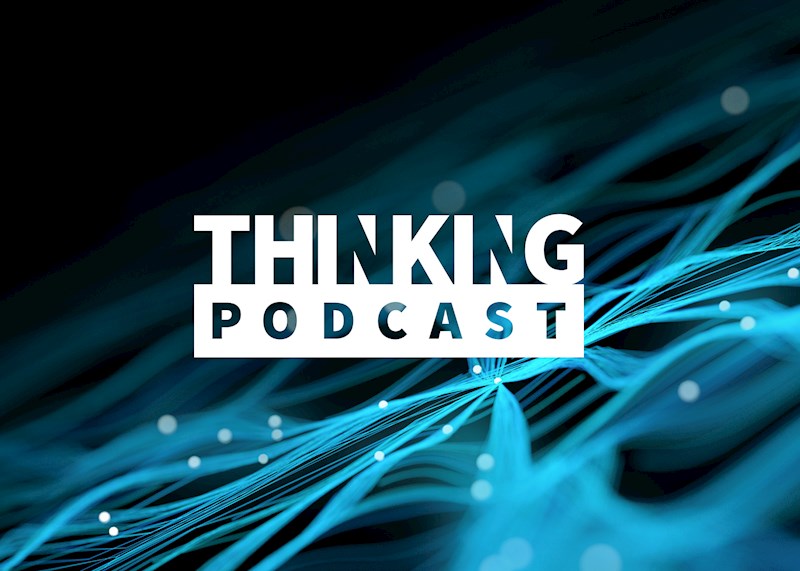William Blair macro analyst Richard de Chazal discusses the Fed’s softer tone, how companies are adapting to tariffs and labor shifts, and why housing and hiring trends are setting the stage for a dynamic second half of 2025.
- Subscribe here:
- Spotify |
- Apple Podcasts |
- Amazon Audible
Podcast Transcript
[00:20] Chris:
All right. Welcome back everybody. It's Friday, June 27th, 2025. And we've got a lot to cover.
Housing is cooling fast. The fed is sounding more cautious. And companies are navigating tariffs, labor tightness and shifting consumer behavior. As always, joining me to break it all down is Richard de Chazal, macro analyst at William Blair, for another episode of Monthly Macro. Richard, always great to have you.
[00:44] Richard:
Great to be back.
[00:45] Chris:
Let's start with the fed. So the June meeting, it didn't bring a rate cut, but the tone definitely softened. You know, what's your read on the Fed's current stance? And then how are they? How are they weighing inflation risks against a slowing labor market?
[00:59] Richard:
Yeah, sure. I mean, I think what changed at this last FOMC meeting was more sort of around the FOMC meeting or actually kind of after the meeting itself, like the meeting itself and Powell's press conference was pretty much as expected. There was no real surprises there. I think he delivered what most people were were expecting, and that was on the Wednesday.
But what was a bit surprising was after that, on the Friday and then on the Monday when on Friday we had Fed Governor Waller come out on CNBC and he sort of gave a much more dovish view than what Powell had presented at the previous FOMC. I mean, he basically said that he thinks the inflationary threats from tariffs was pretty negligible. And actually there was a growing risk of the economy slowing. And then Governor Bowman came out on Monday pretty much said the same thing. Chicago Fed Austan Goolsbee was pretty dovish as well, although he tends to be quite Darvish. So basically you had three speakers all sort of sounding a lot more dovish than what Powell was saying just a few days before.
And you know it leads you thinking sometimes sometimes the fed does feel that maybe the market has misinterpreted what the chair had been trying to convey at the previous press conference. And then you get a series of these, these speakers come out and sort of correct the message, if you will. So when, when that happens, you sort of assess, okay, is this what they're saying or not? And I think, well, we had to do this time around. Fortunately, we had Powell speaking twice this past week for congressional testimony before Congress. So we can really assess whether, you know, he can confirm or deny that sort of take that was being presented by other members of the committee. And what I think we got was Powell, again, sticking to his guns.
And then it's sort of highlighted that maybe these other committee members are a little bit more on the outside, on the dovish end. He's more sort of in the middle on the average. And there are still a few hawkish members yet. So he didn't sort of say that the fed was really changing his, message in, in, in any particular way. And ultimately, I think what we're talking about here is still just like an extra, you know, month and a half, you know, Waller was talking about cutting in July 30th, July 30th FOMC meeting. And I think Powell is really talking about September 17th.
[03:48] Chris:
This is being driven by tariffs and policy uncertainty. Or what is, you know, impacting or causing the shift?
[03:55] Richard:
Yeah, I say that's the bulk of it.
You know, I think tariffs are definitely a game changer for a lot of companies. I think what what they've got to do is, is rethink their strategy. I mean this is, you know, new friction.
You know, they've got to go out and renegotiate with their suppliers. They've got to decide whether they want to continue with certain lines of business. Are they going to relocate production, all of these things. And that's that's creating costs, that's creating frictions. Maybe they need to restructure some some businesses. And it's sort of it kind of throws sand into the working of what had been a pretty smooth running, ultra efficient global supply chains, or maybe another analogy is, well, you know, we're still going from A to B, but we're taking a bit of a detour with sort of more bumps in the road along the way. But, you know, we're still kind of getting there, but it's just not as quite smooth sailing, as it was before.
[04:57] Chris:
Staying on this topic of tariffs, it. They were a, you know, core theme at William Blair's 45th annual Growth Stock Conference earlier this month. And from your conversations there, how would you say companies are thinking about the broader economic environment right now? Would you say they are addressing expectations, bracing for more volatility? Would love to hear your thoughts.
[05:17] Richard:
I mean, I think they're definitely now more comfortable than there were in March and April, when it was just total and complete uncertainty. And I think, well, what we sort of seen since then is President Trump making, you know, some, some concessions that he's willing, you know, he's not going to be as hardline as he maybe first seems.
And I think I think what companies did through the first quarter, well the through their earnings season, is they really adjusted their guidance downwards for the second and third quarters. And then, what we’ve seen was analysts obviously following along from had an, you know, aggressively lowering their EPS expectations. So, it feels like it feels like companies are sort of saying okay, fine. We've marked down our earnings estimates. Analysts followed us. We made provisions for these new changes. And we're kind of comfortable with that. But you know let's just see how the cookie crumbles. And, you know, hopefully we don't have to make another sort of major adjustment. And, but for now, we're sort of comfortable where we are.
[06:27] Chris:
So what was the tone, would you say from companies there. Were they generally optimistic. Cautious? Somewhere in between?
[06:34] Richard:
Always hard to say because I think at these conferences, all these companies want to sound extremely optimistic.
[06:39] Chris:
Right. Yeah that's a good point.
[06:40] Richard:
Nobody wants to tell you anything that, you know, their business looks terrible.
Maybe there wasn't quite the same degree of optimism you normally hear. You know, I think companies just don't know what to have. What, what's going to happen. So maybe they're a little bit cautious. I think they were there was often companies, you know, that you see t every year normally they might spend a little bit more time talking about the near term. Now, maybe they were just sort of skipping over that and getting to kind of their long, longer term growth prospects and how great those are. So, probably I'd say, I guess, you know, to answer your question, probably a little bit in between, you know, optimism, they're not pessimistic, but little, little bit more a little bit more cautious.
[07:24] Chris:
Okay. So moving on. Let's talk a bit about housing. May’s new home sales dropped nearly 14% and housing starts fell almost 10%. What's driving the sharp pullback? Is it mortgage rates, affordability, something deeper? And I know things are consistently changing or continually changing, but would love your thoughts there as well.
[07:44] Richard:
Sure. I mean, affordability is is, you know, a big problem.
[07:50] Chris:
I mean rates are high, right?
[07:52] Richard:
Yeah, it’s a function of, housing is pretty simple. It's just a function of supply and demand. You know, and, that determines the price. You know, the affordability is, is a function of that price. It's a function of mortgage rates. It's a function of lending standards and income growth. And the reality is, is that there's a huge demand for housing on the one side and on the other, you've got this ongoing structural shortage of, homes in the US. So if the supply is not there to satiate demand, prices are going to be high. I think the home builders have been out there trying to do their stuff to add to that supply, but then again, they need to do that in what's a cost effective way.
And then tariffs, deportations, regulation, not enough land to build on isn't really helping. And, you know, listening to what they're saying, they're saying they're being forced to cut prices, which is taking a hit to their margins. So they're not particularly happy about that. And then when mortgage rates are 7%, the problem is that most existing homeowners, you know, are unwilling or unable to sell their homes because they don't want to trade off their current 3% mortgage rate to to jump up to a two to a 7%. So, that would be a big hit to them. And that's this kind of world where we're in where it's sort of grind, grind along and grind, grind a little bit lower.
[09:20] Chris:
Yeah. So the FHFA director recently called for rate cuts to revive housing. Do you think a modest cut would be enough to stabilize the market, or are we looking at a longer reset?
[09:31] Richard:
Yeah, I think, I think, you know, it's probably not going to take all that much of a decline in mortgage rates to get this market going again. My guess is that once you get those rates heading closer to 6%, you're going to start to see some even decent movement.
[09:46] Chris:
Sure. Okay.
[09:47] Richard:
We’ve already seen that any time that mortgage rate comes down even a little, you get a pretty good response from home buyers. So there's definitely some some good sensitivity there. I guess the one problem is that mortgage rates are priced off of the ten year and not the Fed funds rate. So, you know, how responsive is that longer end of the curve to what the Fed’s doing at the shorter end of the curve because you got, you got a whole lot of other things that that drive that long and not, not just, 100% what's, what's happening in the, at the short end. So, you know, how steep does that yield curve go? And how responsive are those mortgage rates to what's happening in the short end to the curve?
[10:30] Chris:
Okay. Let's turn to the labor market. You know, you recently highlighted a cooling trend, not a collapse. But a cooling trend. What are the key signals you're watching? You know, maybe along the lines of jobless claims, layoff announcements, hiring intentions. What are you looking at?
[10:45] Richard:
All of of the above, you know, I think, anything, anything you can get your hands on, I think is, is helpful. I don't think there's one perfect gauge which which gives you the whole picture. And in fact, actually the the Kansas City Fed has a, labor market conditions basket, which, which encompasses 24 different labor market indicators. So, that's that's kind of useful. But I think at the moment, what we're seeing is a market where companies are definitely hiring less. So we're seeing job openings are coming down. We did see a spike in layoff announcements. I think the vast majority of that was in the government sector. So, the DOGE…
[11:38] Chris:
Yeah. It didn't seem there were cuts, but it didn't seem like it was anything out of the ordinary.
[11:42] Richard:
There was a huge amount of announcements made. And this is a difference between announcements and actual cuts. So the DOGE announced 15,000 cuts here or there. And, whether that's the reality or not. And then government, you know, the courts came and and overruled some of those cuts. Those workers went back to work. So, it didn't actually translate into, into all that, that, that were announced. And similarly, like we've, we've heard a few big tech companies, one big consumer staples company talking about or announcing layoffs. And again, if you actually read their press statements, you know, these could be announcements that are not just in the US, they could be global.
They could be announcements that are over like, three years, four years. And I think they're also gross numbers. So it doesn't necessarily net off what hiring they're actually doing. So I mean, they're, they're important indicator. Don’t get me wrong. But I think what we've seen is we've seen a huge spike in those announcements and hasn't yet been followed through with actual, like, initial jobless claims. And that kind of thing.
[12:55] Chris:
Right. The labor market. You know, you noted this as well, I think, in the same report. The labor market is structurally tight thanks to demographics and immigration trends. So how does that shape the Fed's thinking and the broader economic outlook for you?
[13:08] Richard:
I think that's right. I think what you've got is a slower birth rate at one end and then at the other, you got the baby boomers moving out of the labor market. And then you're tightening up on, on immigration. You've got some deportations going on. So the supply of labor is, is not nearly as cheap and plentiful as it once was, say, a decade or so ago. So, that’s a pretty significant change. And I think what, what it means for the Fed was, you know, in that old world, wage pressures weren't such a big deal. And, I think now in a labor market, they have to be more appreciative of those wage pressures than they previously would. And I think, you know, for us watching the non-farm payroll data, for example, as well, in a smaller labor force, you know, where is it used to maybe take a payroll number of 125,000, 150,000 to keep the unemployment rate stable. Now that starts to come down, maybe we're sort of 90,000. I've seen estimates that are even lower to actually keep that unemployment rate from from rising. So I think that's also something we need to be cognizant of as well.
[14:31] Chris:
All right, so last question, and I believe I asked the same question last month, but, let's talk positioning. So everything we've discussed, Fed policy, housing, labor, tariffs, infrastructure, you know, what sectors or asset classes look most attractive right now? Are SMIDcaps still in favor? You know, have there been any shifts in your outlook since last month?
[14:50] Richard:
Not really, I would say. If we look at the big picture, we're seeing regime changes in a number of different areas. We're seeing it in the dollar. You know, the dollar has been in a bull market for the last, since 2011 has gone up something like 50% in real inflation adjusted terms. I think that's starting to to roll over. And that has implications for for financial markets.
I think the inflation regime we've talked about before, we're sort of shifting from a one where there was mostly just downside risks to inflation and very little upside risk to one where there's going to be more volatility around maybe a slightly higher mean level of inflation. And then we're also in sort of a world where there's more active involvement from fiscal policymakers in into economic management. And that means, that the Fed has to be more reactive and less preemptive in, you know, Fed puts and things like that, which is kind of what we're seeing, you know, exactly today. And then we're still in this huge AI, you know, major structural trend. And I think we're very, very early in that. And so I think, you know, we're in this sort of new world. I think uncertainty is going to be a little bit higher. Volatility is going to be a little bit higher. And I think what investors need to do in this world is one look for more diversification. So again across sectors and across size.
So instead of just being in your kind of long duration portfolio of just long duration tech stocks, balance out with some bonds. You may have to hold some areas like, you know, industrials or financials or things you wouldn't necessarily have wanted to hold for and similarly across the size. So that's why I think mid-caps are quite attractive there. And then the other thing aside from diversification is valuation because that helps give you a little bit more of a cushion against that uncertainty. And then again, I think a lot of these, sectors or areas that have really been overlooked for, for a while actually have, very, very attractive valuations at the moment. So it's a question of getting a little bit more of a balanced portfolio, with a valuation cushion there against some of that uncertainty.
[17:09 Chris:
Richard, that's all the time we have for today. Thanks for the insights. As usual, it's always a pleasure. I we'll be back next month to see how these trends evolve.



